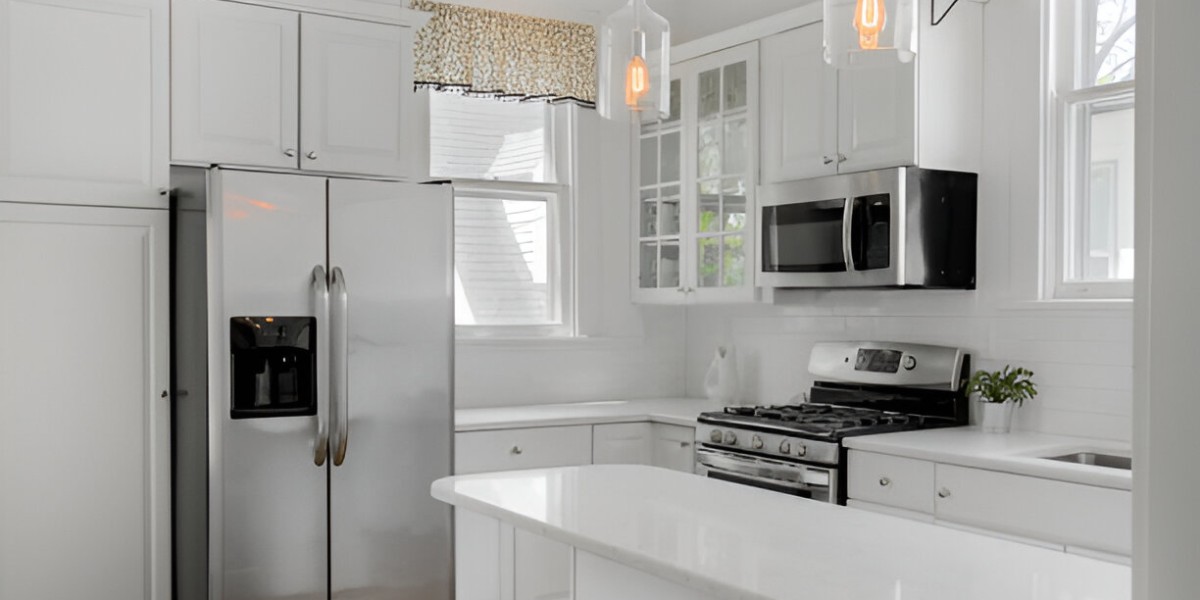Introduction
Your kitchen is not just a place to cook; it's the central hub of your home. When it comes to designing or remodeling this essential space, many homeowners are drawn to styles that blend timeless elegance with modern convenience. One style that perfectly balances these qualities is the transitional style kitchen. If you're looking to create a kitchen that combines traditional charm with a contemporary twist, the transitional style might be your perfect match.
What’s a Transitional Style Kitchen?
A transitional kitchen is all about blending the best of both worlds: classic and modern design elements. This style creates a space that's elegant yet practical, merging timeless features with modern updates for a balanced and inviting look.
In a transitional style, you'll see sleek lines and neutral colors mixed with traditional details and rich textures. It’s a style that avoids being too formal or too casual, making it ideal for those who appreciate the beauty of classic design but also want the convenience of modern living.
Key Features of a Transitional Style Kitchen
1. Neutral Colors
One of the standout features of a transitional style kitchen is its use of neutral colors. Think shades like white, gray, beige, and taupe. These colors create a calm, sophisticated atmosphere and offer flexibility in mixing both traditional and modern elements.
For instance, pairing white cabinets with a gray backsplash can give your kitchen a timeless yet fresh look. Neutral tones also make a space feel larger and more open, which is great for smaller kitchens.
2. Classic Meets Contemporary Cabinets
In a transitional kitchen, cabinetry often merges classic and modern touches. Shaker-style cabinets, known for their clean lines and simple design, are a popular choice. They offer a timeless look that complements both traditional and contemporary decor.
To modernize the look, consider adding sleek hardware or some open shelving. This blend of old and new ensures your cabinets enhance the overall design without stealing the show.
3. Elegant Countertops
Countertops play a big role in a transitional style kitchen. Materials like granite, quartz, and marble add a touch of luxury while being durable and functional.
For example, a classic white marble countertop with subtle gray veining can add a sophisticated touch while keeping the space balanced and elegant.
4. Stylish Lighting
Lighting can make a huge difference in your kitchen's design. Combining different lighting types—like pendant lights, recessed lighting, and under-cabinet lights—creates a layered effect that’s both functional and beautiful.
A statement chandelier over the island or dining area adds a touch of elegance, while recessed lighting provides practical illumination for cooking and prepping.
5. Textures and Finishes
Textures and finishes are key to achieving the right balance in a transitional style. Mixing smooth surfaces with textured backsplashes or combining polished countertops with matte fixtures adds depth and interest.
Natural materials, like wood and stone, can also help blend traditional and modern elements. For example, a wooden island with a stone countertop creates a beautiful contrast that enhances the overall design.
6. Practical Layout
Functionality is crucial in any kitchen design, and the transitional style is no exception. A well-thought-out layout ensures your kitchen is both stylish and practical.
Think about an open floor plan, ample storage, and an efficient work triangle to make your kitchen as enjoyable to use as it is to look at.
7. Personal Touches
While the transitional style kitchen combines traditional and contemporary elements, it’s important to add personal touches that reflect your style. Custom cabinetry, unique accessories, or artwork can make the space truly yours.
Personal touches ensure your kitchen doesn’t just look great but feels like a genuine reflection of you and your lifestyle.
Why Choose a Transitional Style Kitchen?
1. Timeless Elegance
A major benefit of a transitional kitchen is its timeless appeal. By blending classic and modern elements, this style creates a look that remains stylish for years to come. You won’t have to worry about your kitchen falling out of fashion as design trends change.
2. Versatility
The transitional style is incredibly versatile. Whether you lean more towards traditional or contemporary preferences, this style can accommodate both, allowing you to adapt the design to suit various tastes and needs.
3. Functional Beauty
With a focus on functionality, the transitional style kitchen doesn’t just look good—it works well too. This means you can enjoy a beautifully designed space that meets your practical needs.
4. Easy Integration
If your home has a mix of traditional and contemporary decor, a transitional kitchen will fit right in. Its ability to blend with different styles helps create a cohesive look throughout your home.
Tips for Designing Your Transitional Kitchen
1. Plan Your Layout
Before diving into your kitchen design, take some time to plan the layout. Consider the flow of the space, where key elements will go, and how you can balance style with function.
2. Invest in Quality Materials
Choosing high-quality materials is key to achieving a refined look. Opt for durable materials that are both beautiful and long-lasting.
3. Balance Old and New
The magic of a transitional style kitchen lies in balancing traditional and modern elements. Avoid overwhelming the space with too many ornate details or overly sleek features. Instead, aim for a harmonious blend.
4. Layer Your Lighting
Use a mix of lighting types to create a layered effect that enhances both function and ambiance. This helps highlight the best features of your kitchen.
5. Add Personal Touches
Finally, don’t forget to add personal touches that make the space feel uniquely yours. Whether it’s through custom features, accessories, or artwork, these details will make your transitional kitchen truly special.
Conclusion
The transitional style kitchen offers a perfect blend of classic elegance and modern convenience. By incorporating elements like neutral colors, a mix of cabinetry styles, elegant countertops, and thoughtful lighting, you can create a space that’s both beautiful and functional. This style’s timeless appeal, versatility, and focus on functionality make it an excellent choice for any home.
Whether you’re remodeling an existing kitchen or designing a new one, the transitional style lets you merge the best of both worlds. Embrace the charm of a transitional kitchen and enjoy a space that’s not only stylish but also the heart of your home.








